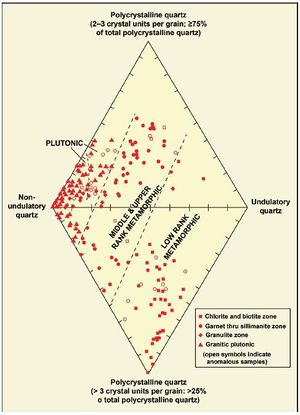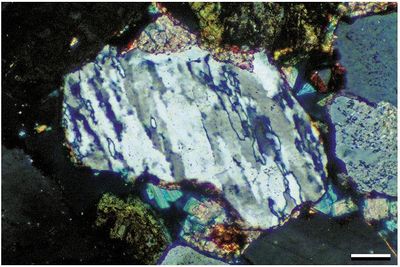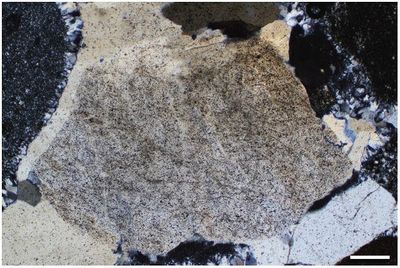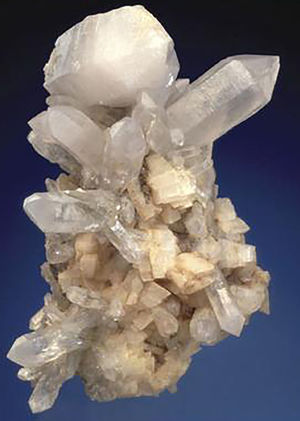Quartz
| A Color Guide to the Petrography of Sandstones, Siltstones, Shales, and Associated Rocks | |
| 120px | |
| Series | Memoir |
|---|---|
| Chapter | Grains: Quartz and Silica |
| Author | Dana S. Ulmer-Scholle, Peter A. Scholle, Juergen Schieber, Robert J. Raine |
| Link | Web page |
| Store | AAPG Store |
Quartz (SiO2) is the most abundant mineral in terrigenous sedimentary rocks and is exceedingly durable (surviving multiple generations of weathering and deposition). Quartz and silica occur in many varieties—true quartz in the form of megaquartz, chert, microquartz, or chalcedony and various other forms of silica, mainly opal (opal-A and opal-CT [cristobalite]).
Major characteristics
Color: Typically clear, but cloudy and colored varieties occur where crystals are especially rich in water or mineral inclusions. In thin section, these colors are rarely seen, although red and pale brown varieties related to included hematite and limonite are sometimes found.
Common crystal habit: Hexagonal, bipyramidal.
Pleochroism: None.
Cleavage/fracture: No cleavage, but fractures and healed fractures can be common.
Relief and optic sign: Low; uniaxial (+).
Birefringence: First-order (in a 30-μm section) typically first-order white and gray to pale straw yellow.
Other: No twinning; may contain trains of water, gas or mineral inclusions including ones, such as rutile and tourmaline needles, that may provide clues to grain provenance. Optical behavior varies based on deformation history; grains can have undulatory (undulose or sweeping) or nonundulatory (nonundulose or straight) extinction. Quartz grains commonly have syntaxial quartz overgrowths that form diagenetically.
Minerals that may have similar appearance
Feldspars: Commonly show some cleavage, more alteration (vacuolization, sericitization, partial to complete dissolution), presence of characteristic twinning patterns and are biaxial. Can be differentiated by staining.
Apatite: Normally lower birefringence, has a higher relief and is uniaxial (-).
Gypsum and barite: Both have birefringence similar to quartz, but barite has slightly higher relief and gypsum has lower relief; both gypsum and barite have strong cleavage.
Zeolites: Numerous zeolite minerals can be confused with fibrous varieties of quartz. Most of the common zeolite minerals are biaxial (+/) and most have somewhat lower birefringence than quartz.

Provenance indicators
Quartz can occur as single crystals or polycrystalline aggregates that may provide clues to the provenance of the grains, but quartz is common to most rock types other than basalts (see the table below). Semicomposite and polycrystalline quartz can be found in metamorphic and plutonic rocks as well as hydrothermal vein deposits and fractures. For metamorphic quartz, the size of the crystals may represent increasing metamorphic grade; larger crystals form under higher temperatures and pressures (Figure 1).
| Quartz types/source | Extinction characteristics | Other features |
|---|---|---|
| Common or plutonic (granitic or many others) | Unit (straight) to slightly undulatory | Some vacuoles and/or microlites; subsequant to xenomorphic grains |
| Vein or pegmatitic | Unit or semi-composite to undulatory, possible shearing | Abundant vacuoles, possible vermicular chlorite; comb structure common; typically found in large clasts |
| Volcanic | Unit (straight) | Euhedral bipyramidal shapes, round corners, and straight sides with embayments; virtually no inclusions; posssible negative crystals |
| Schistose metamorphic | Unit to slightly undulatory | Elongate composite grains with straight borders; common mica inclusions |
| Stretched metamorphic | Strongly undulatory; subunit borders crenulate, granulate, or smooth | Elongate, lenticular-shaped crystal subunits; some microlites and vacuoles |
| Recrystallized metamorphic | Unit to slightly undulatory | Straight boundaries between equant interlocking grains in a mosaic; some microlites or vacuoles |
Grain size can make provenance determination more difficult. With decreasing grain size, the ability to see undulatory quartz or polycrystalline/composite grains becomes more difficult. Since crystal sizes within polycrystalline grains may be large, grains formed from their breakdown may not exhibit polycrystallinity or undulatory extinction.
Chert and opaline silica can be found in either sedimentary or volcanic rocks — in the former as direct precipitates and in the latter as recrystallized glass.
Common inclusions and provenance
Amphiboles (actinolite and others): metamorphic, intermediate to mafic igneous rocks and skarn deposits.
Apatite: felsic to intermediate volcanic rocks, skarns, carbonatites, calcium-rich metamorphic rocks, pegmatites and hydrothermal vein deposits.
Chlorite: fracture fills in low to medium grade metamorphic rocks, skarns and pegmatites.
Iron oxides (hematite, goethite and others): very common, and they form in a variety of environments ranging from anoxic (magnetite) to highly oxidizing (hematite, goethite) and low (goethite), medium (hematite) to high temperature (magnetite) conditions.
Sillimanite: metamorphic rocks.
Titanium minerals (such as rutile, titanite, anatase and others): metamorphic rocks, pegmatites and hydrothermal vein deposits.
Tourmaline: pegmatites.
Zircon: common in igneous and metamorphic rocks.
Hydrocarbons, bitumen and methane: trapped during growth of the quartz crystals from fluids containing organics. These can sometimes be used to reconstruct basin temperature and fluid histories.
Petrographic examples


See also
References
- ↑ Basu, A., S. W. Young, L. J. Suttner, W. C. James, and G. H. Mack, 1975, Re-evaluation of the use of undulatory extinction and polycrystallinity in detrital quartz for provenance interpretation: Journal of Sedimentary Research, v. 45, p. 873–882, doi: 10.1306/212F6E6F-2B24-11D7-8648000102C1865D.
- ↑ Krynine, P. D., 1946, Microscopic morphology of quartz types: Annals of 2nd Pan-American Congress of Mining and Geological Engineers, p. 35–49.
- ↑ Folk, R. L., 1980, Petrology of sedimentary rocks: Texas Hemphill’s Book Store, Austin, 182 p.
